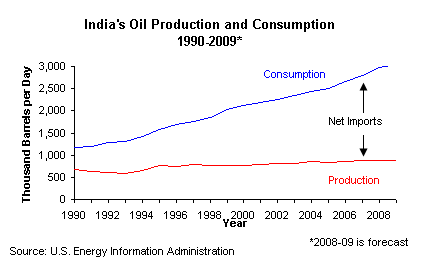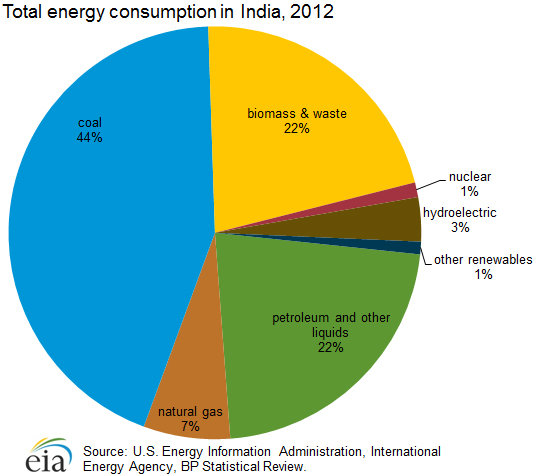Today I will focus on India’s current energy use and the policy decisions that are associated with its energy needs. Next week I will focus on future plans with an emphasis on mitigation and adaptation to climate change. This should provide all of us with a decent background to try to anticipate India’s “vote” in the coming 2015 Paris global meeting where nations around the world will try to draft a worldwide plan to achieve these objectives.
I will start with data about India’s present (2012) energy use and its self-sufficiency in providing enough energy to fuel its development aspirations. Figure 1 shows the 2012 energy mix and Figure 2 shows the trend in energy production and energy consumption over the last 20 years. Production is constant over this period, but consumption tripled to fuel economic growth. Such a trend is an obvious recipe for instability.
 Figure 2
Figure 2
The key realities that India is trying to address are summarized below:
Of the 1.4 billion people of the world who have no access to electricity in the world, India accounts for over 300 million. The International Energy Agency estimates India will add between 600 GW to 1,200 GW of additional new power generation capacity before 2050.[15] This added new capacity is equivalent to the 740 GW of total power generation capacity of European Union (EU-27) in 2005. The technologies and fuel sources India adopts, as it adds this electricity generation capacity, may make significant impact to global resource usage and environmental issues.[16]
Some 800 million Indians use traditional fuels – fuelwood, agricultural waste and biomass cakes – for cooking and general heating needs. These traditional fuels are burnt in cook stoves, known as chulah or chulha in some parts of India.[17][18] Traditional fuel is inefficient source of energy, its burning releases high levels of smoke, PM10 particulate matter, NOX, SOX, PAHs, polyaromatics, formaldehyde, carbon monoxide and other air pollutants.[19][20][21] Some reports, including one by the World Health Organisation, claim 300,000 to 400,000 people in India die of indoor air pollution and carbon monoxide poisoning every year because of biomass burning and use of chullahs.[22] Traditional fuel burning in conventional cook stoves releases unnecessarily large amounts of pollutants, between 5 to 15 times higher than industrial combustion of coal, thereby affecting outdoor air quality, haze and smog, chronic health problems, damage to forests, ecosystems and global climate. Burning of biomass and firewood will not stop, these reports claim, unless electricity or clean burning fuel and combustion technologies become reliably available and widely adopted in rural and urban India. The growth of electricity sector in India may help find a sustainable alternative to traditional fuel burning.
The International Energy Agency (IEA) mentioned has written an assessment of India’s present energy policy with the following pessimistic conclusion:
“India’s energy sector is increasingly unable to deliver a secure supply of energy amid growing demand and fuel imports.”
From there it proceeds to describe the policy objectives:
Three main energy policy objectives are pursued by the Indian government:
First, access to energy is the foremost goal in India’s energy policy making, as nearly one-quarter of the population lacks access to electricity. This implies ensuring the supply of adequate and reliable energy to the Indian population amid growing energy demand, bolstered by economic growth.
Second, energy security is driven by increasing dependence on imported fuels, which is crucial to meet the India’s huge energy demand. Increased import dependence also exposes the country to greater geopolitical risks and international price volatility.
Finally, India is dedicated to the mitigation of climate change, although overcoming energy poverty and ensuring economic and social development remains a top priority.
As the IEA notes, there are often conflicts between the objectives. Here is what they write about energy access and energy security:
Nearly one-quarter of the population of India lacks access to electricity. It is important to understand this peculiarity of India’s energy situation where the majority of potential energy demand still remains unmet, unlike most developed countries where energy demand has reached or is close to saturation stage. The Indian government recognized that economic development is being hindered as a consequence of energy poverty. Thus, providing energy access to its entire population has been a top priority of Indian policy makers for a long time, making it equally or even more important than energy security. India’s major rural electrification scheme is an example of the government’s determination to expand access to electricity in India’s rural villages.
Energy security takes a central position in government policy making. The emphasis of energy policy until the 1990s was on electricity shortage and unsatisfied energy needs. However, increasing dependence on imported energy sources, mainly oil, but also natural gas and coal, resulted in greater government attention to the subject. Energy security is defined comprehensively in India, as “we are energy secure when we can supply lifeline energy to all our citizens irrespective of their ability to pay for it as well as meet their effective demand for safe and convenient energy to satisfy their various needs at competitive prices, at all times and with a prescribed confidence level considering shocks and disruptions that can be reasonably expected” (PC, 2006).
From this definition, India’s concern for energy security is threefold: First, India asserts that energy is a lifeline to all citizens, which should be factored into its energy security strategy. Second, India is anxious about sudden increases in global energy prices as they undermine the availability of energy to its people and exacerbate the national financial burden. Finally, there is a concern about possible abrupt supply disruption, which has led to efforts to diversify supply and fuel and acquire overseas assets.
It should be interesting to figure out how this reality maps into concern and action to meet the global demand to mitigate against climate change. We will have to wait until next week to address this matter.

 Figure 1
Figure 1
India is starting to paying attention to increase the use of the energy since it is the third country behind The US and China which has more energy emission. There is more than 300 million people have not gotten an electricity in India which makes the government try to solve this problem by using the new energy.
the importance of putting the energy policy has been rising in India as they realized the extensive need of energy for development, and for economic growth. As many study showed that almost 600 million Indians do not have access to electricity and approximately 700 million Indians use biomass as energy resource. as a result , India have plans to reduce the use of the fossil fuel and use other sources and supply people with energy in rural and urban area although they have big concerns about the rise of the energy price in world market and other concerns.Hopefully India can apply its ambitious plans and cut the emission of CO2.
India should tend to use other energy sources that cannot negetivelly effect there population. On other word, they should harness the renewable energy sources to overcome the poverty of energy generation for the increasing number of population. It should be a nearly equivalent amount of production and consumption of energy. In addition, the use of sustainable energy can led to mitigate the climate change over the country which will be a helpful and tangible solution to solve part of energy sources issue throughout India.
India occupies third place in the world after China and the United States, in carbon dioxide emissions, which have doubled this year and until 2030. India needs to get the advantage of the modern technology. Since one – quarter of its population lacks access to the electricity, the diversity in the use of renewable energy such as solar and wind power and other, and not rely on one source of energy will be the best solution to get away from pollution. In addition, from the chart, India depends on cole so when they want to reduce pollution they have to reduce using raw materials and rely on the clean energy.
The conflicts that the IEA brings up are of significant importance. I feel that because of the many issues between these objectives, as well as government regulation and policy, that it will take way more than the Paris 2015 convention to address all of India’s, as well as other underdeveloped countries trying to mitigate climate change while trying to become a developed country. The one main good thing about this is that even though it will take a while, at least there are ways to mitigate climate change before it becomes to late for these underdeveloped countries. And eventually, the process of addressing all of the changes that an underdeveloped country will have to go through will be executed quicker and smoother.